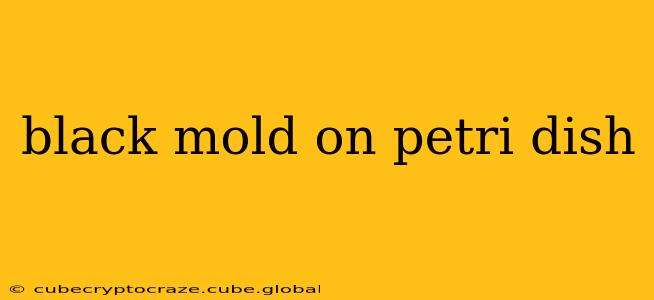Black mold on a petri dish is a common sight in microbiology labs, but it can also appear unexpectedly in home science experiments or contaminated food samples. Identifying the specific type of mold requires expertise, but understanding the general causes and appropriate handling procedures is crucial for safety and accurate results. This guide will delve into the various aspects of black mold found on a petri dish, answering common questions and offering valuable insights for both novices and experienced researchers.
What causes black mold to grow on a petri dish?
Black mold growth on a petri dish typically stems from fungal spores present in the surrounding environment. These spores are ubiquitous and can easily contaminate the agar medium used in petri dishes if proper aseptic techniques aren't followed. Factors contributing to mold growth include:
- Contamination: Improper sterilization of equipment (petri dishes, inoculating loops, etc.), the agar medium itself, or the surrounding air can introduce fungal spores. Even a tiny speck of dust can harbor numerous spores.
- Nutrient Availability: The agar provides a rich nutrient source for fungal growth. Different types of agar support different types of mold.
- Moisture and Temperature: A moist environment and suitable temperature range are essential for mold proliferation.
- Airborne Spores: The air is teeming with fungal spores; these can settle on the surface of the agar, germinate, and form colonies.
How can you identify the type of black mold on a petri dish?
Identifying the specific type of black mold requires microscopic examination and potentially advanced laboratory techniques. Visual identification alone is unreliable, as many different fungi can produce black or dark-colored colonies. The morphology (shape and structure) of the mold colonies, spores, and hyphae (thread-like filaments) is crucial for accurate identification. This is usually performed by trained mycologists using techniques like:
- Microscopic observation: Examining the mold under a microscope to observe its microscopic characteristics.
- Culture techniques: Growing the mold in different culture media to observe its growth patterns.
- Molecular techniques: Using DNA sequencing to identify the specific fungal species.
Is black mold on a petri dish dangerous?
The danger posed by black mold on a petri dish depends entirely on the specific species involved. Some black molds are relatively harmless, while others can produce mycotoxins (toxic compounds) that pose health risks if inhaled or ingested. It's crucial to avoid direct contact with the mold and to dispose of the petri dish properly, especially if you are unsure of its identity. Never smell or touch the mold directly.
How should you dispose of a petri dish with black mold?
Proper disposal of a petri dish with black mold is crucial to prevent further contamination and potential health risks. The following steps are recommended:
- Autoclaving (if possible): This is the most effective method for killing the mold and rendering the petri dish safe for disposal. Autoclaving involves using high-pressure steam to sterilize materials.
- Disinfection: If autoclaving isn't available, soak the petri dish in a strong disinfectant solution (e.g., 10% bleach solution) for at least 30 minutes before discarding.
- Secure Disposal: Wrap the disinfected petri dish in several layers of plastic bags and dispose of it in accordance with your local regulations for biohazardous waste.
What are the safety precautions when handling petri dishes with mold?
When handling petri dishes that might contain mold, always adhere to strict safety precautions:
- Wear appropriate protective gear: This includes gloves, a lab coat, and eye protection. A respirator mask may be necessary if there's a risk of inhaling spores.
- Work in a well-ventilated area: This helps to minimize the inhalation of mold spores.
- Avoid creating aerosols: Avoid shaking or forcefully disturbing the petri dish to prevent the release of mold spores into the air.
- Proper hand hygiene: Wash your hands thoroughly with soap and water before and after handling the petri dish.
How do I prevent black mold growth on a petri dish?
Preventing black mold growth requires meticulous aseptic techniques:
- Sterilization: Sterilize all equipment (petri dishes, inoculating loops, etc.) thoroughly before use.
- Aseptic technique: Employ strict aseptic techniques throughout the experiment to minimize contamination.
- Proper storage: Store petri dishes in a clean, dry, and cool environment.
By following these guidelines, you can minimize the risk of black mold growth and ensure the accuracy and safety of your experiments. Remember that identifying the specific type of mold requires expert knowledge; if unsure, treat the mold with caution and seek professional advice for proper disposal.
